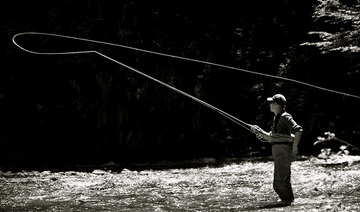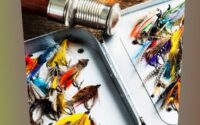| Disclosure: Just to be open and honest the buttons and links you click on in the website will in most cases take you to another website where you can purchase the products I am reviewing. As an Amazon Associate I earn from qualifying purchases. |
Can You Make Money Tying Fishing Flies? Business Ideas
Quick Post Navigation
- Introduction
- History of Fly Tying
- The Art and Craft of Fly Tying
- Types of Flies
- Market Demand for Fishing Flies
- Ways to Make Money Tying Fishing Flies
- Challenges and Considerations
- Success Stories
- Legal and Regulatory Considerations
- Tips for Beginners
- Marketing Your Fly Tying Business
- Scaling Your Business
- The Future of Fly Tying
- Conclusion
- FAQs
- “Check out some of our other Buying Guides”

Introduction
Fly tying is a centuries-old craft that combines artistic expression with practical utility. At its core, fly tying involves creating artificial flies that mimic the appearance and behavior of natural insects, larvae, or baitfish. These flies are used by anglers for fly fishing, a method of fishing that relies on casting lightweight flies onto the water’s surface to entice fish. The art of fly tying has evolved over time, blending traditional techniques with modern innovations to produce an array of intricate patterns tailored to various fishing conditions and target species.
History of Fly Tying
The history of fly tying traces back to ancient civilizations, where early anglers fashioned crude imitations of insects using feathers, fur, and other natural materials. Over time, fly tying techniques became more refined, with distinct styles emerging in different regions of the world. In Europe, for example, fly tying flourished during the Victorian era, with renowned anglers and fly tiers developing elaborate patterns to suit the diverse ecosystems found across the continent. In America, fly tying gained popularity in the 19th century, spurred by the emergence of fly fishing as a recreational pursuit among affluent urbanites. Today, fly tying continues to evolve, with contemporary fly tiers drawing inspiration from tradition while embracing modern materials and technologies.
The Art and Craft of Fly Tying
To engage in fly tying, one must possess a basic understanding of entomology—the study of insects—as well as proficiency in various tying techniques. Fly tying materials range from natural elements like feathers, fur, and dubbing to synthetic materials such as threads, wires, and synthetic fibers. A well-equipped fly tying bench typically includes tools like a vise, scissors, bobbins, and hackle pliers, each serving a specific function in the tying process. Mastering fundamental techniques like thread wrapping, feather manipulation, and dubbing application is essential for producing flies that are both aesthetically pleasing and functional in the water.
Types of Flies
Fly patterns are classified into various categories based on their design, purpose, and fishing application. Dry flies, for instance, are designed to float on the water’s surface and imitate adult insects like mayflies, caddisflies, and stoneflies. Wet flies, on the other hand, are designed to sink below the surface and mimic subaquatic insects or baitfish. Nymphs are another common category of flies, representing the immature stages of aquatic insects found beneath the water’s surface. Streamers are large, flashy flies designed to imitate baitfish or other large aquatic prey, often used in pursuit of predatory species like trout, bass, and pike. Emergers are a specialized category of flies that imitate insects transitioning from aquatic nymphs to airborne adults, making them particularly effective during insect hatches.
Market Demand for Fishing Flies
The market for fishing flies is driven by the demand from anglers seeking to enhance their fishing experience and improve their chances of success on the water. Anglers vary in their preferences for fly patterns, with some favoring traditional designs while others gravitate towards innovative or custom-tied flies. Market demand is influenced by factors such as geographic location, seasonal fishing conditions, and target species. For example, trout anglers may favor dry flies during mayfly hatches in the spring, while bass anglers may opt for streamers or topwater poppers in the summer. Understanding these market dynamics is essential for fly tiers seeking to capitalize on emerging trends and meet the evolving needs of anglers.
Ways to Make Money Tying Fishing Flies
Entrepreneurs have multiple avenues for monetizing their fly tying skills, ranging from selling directly to consumers to supplying retail outlets and online marketplaces. Direct sales allow fly tiers to connect with customers on a personal level, offering custom-tied flies tailored to individual preferences and fishing conditions. Supplying to fishing shops and outfitters provides an opportunity to reach a broader audience, leveraging established distribution channels and retail networks. Online platforms and marketplaces offer a global reach, allowing fly tiers to showcase their products to a diverse audience of anglers worldwide. Additionally, offering fly tying classes or workshops can generate supplemental income while fostering community engagement and knowledge sharing within the fly fishing community.
Challenges and Considerations
Despite the potential for profit, the fly tying business comes with its share of challenges and considerations. Competition within the market can be fierce, with numerous fly tiers vying for the attention of discerning anglers. Maintaining quality control is essential for preserving brand reputation and customer satisfaction, requiring meticulous attention to detail and craftsmanship. Pricing strategies must strike a balance between affordability and profitability, taking into account factors such as material costs, labor, and market demand. Effective marketing and branding are critical for standing out in a crowded marketplace, requiring creativity, consistency, and a deep understanding of the target audience.
Success Stories
Numerous individuals have turned their passion for fly tying into successful businesses, carving out niches in the market and building loyal customer bases. Success stories abound across the fly fishing industry, from independent fly tiers operating out of home studios to established brands with international recognition. Learning from these success stories can provide valuable insights and inspiration for aspiring entrepreneurs, showcasing the diverse paths to success within the fly tying community.
Legal and Regulatory Considerations
Navigating legal and regulatory frameworks is essential for ensuring compliance and mitigating risk within the fly tying business. Copyright issues may arise when replicating existing fly patterns or incorporating trademarked materials into fly designs, necessitating careful attention to intellectual property rights. Licensing requirements may vary depending on the jurisdiction and scale of the fly tying operation, with some regions imposing restrictions on the sale of certain types of flies or materials. Environmental regulations are also a concern, particularly regarding the sourcing and use of natural materials like feathers and fur from protected species. Staying informed about these legal and regulatory considerations is essential for operating a lawful and ethical fly tying business.
Tips for Beginners
For novice fly tiers embarking on their journey, patience, practice, and perseverance are essential virtues. Starting with simple patterns and gradually expanding your repertoire allows for skill development and confidence building over time. Investing in quality tools and materials is advisable, as they can enhance the tying experience and improve the durability and effectiveness of the flies produced. Seeking guidance from experienced fly tiers through mentorship programs, online forums, or community workshops can accelerate the learning process and provide valuable insights and feedback.
Marketing Your Fly Tying Business
Establishing a strong brand presence is crucial for attracting customers and differentiating your fly tying business in a competitive market. Building a visually appealing and user-friendly website serves as a digital storefront, showcasing your fly patterns, pricing, and ordering information to potential customers. Leveraging social media platforms like Instagram, Facebook, and YouTube allows for targeted marketing and engagement with the fly fishing community, fostering relationships and building brand loyalty. Collaborating with influencers, sponsoring fishing events, and participating in trade shows are additional strategies for increasing brand visibility and expanding your customer base.
Scaling Your Business
As demand for your flies grows, scaling your fly tying business becomes a natural progression. Outsourcing production to trusted collaborators or hiring additional tiers can increase productivity and expand your capacity to fulfill orders. Diversifying your product range by introducing new fly patterns, accessories, or merchandise appeals to a broader audience and maximizes revenue potential. Expanding into complementary areas such as fly fishing guiding, equipment sales, or educational services further diversifies your revenue streams and solidifies your position within the fly fishing industry.
The Future of Fly Tying
Looking ahead, the future of fly tying holds exciting possibilities fueled by technological advancements, sustainability initiatives, and evolving consumer preferences. Innovations in materials and manufacturing techniques enable fly tiers to push the boundaries of creativity and craftsmanship, producing flies that are more realistic, durable, and effective than ever before. Embracing sustainable practices such as ethically sourcing materials and minimizing waste contributes to the long-term viability of the fly tying industry and ensures the preservation of natural ecosystems for future generations. Emerging trends such as fly tying subscription services, virtual tying events, and eco-friendly fly patterns reflect the evolving needs and values of anglers in an ever-changing world.
Conclusion
In conclusion, the question of whether you can make money tying fishing flies is not just a matter of possibility but one of opportunity and potential. By honing your skills, understanding market dynamics, and embracing innovation, you can turn your passion for fly tying into a profitable and fulfilling business venture. Whether you’re a seasoned professional or a novice enthusiast, the journey of fly tying offers endless opportunities for creativity, discovery, and connection within the vibrant and diverse fly fishing community.
FAQs
Q) How much can you earn by tying fishing flies?
A) Earnings can vary widely depending on factors such as skill level, market demand, and business strategy. Some proficient fly tiers generate a substantial income through direct sales, wholesale distribution, or teaching workshops, while others may earn more modest supplemental income from part-time or hobby-based pursuits.
Q) Is fly tying a profitable business?
A) With dedication, determination, and strategic planning, fly tying can indeed be a profitable and rewarding venture. Success in the fly tying business requires a combination of craftsmanship, market knowledge, and entrepreneurial acumen, along with a willingness to adapt to changing trends and consumer preferences.
Q) What materials do I need to start tying flies?
A) Essential materials for fly tying include feathers, fur, threads, hooks, and a variety of specialized tools such as a vise, scissors, and hackle pliers. Beginners can start with basic fly tying kits containing essential materials and tools, gradually expanding their collection as they gain experience and confidence in the craft.
Q) Can I learn fly tying on my own?
A) Absolutely! While formal instruction and mentorship can accelerate the learning process, many fly tiers are self-taught enthusiasts who learn through trial and error, experimentation, and online resources such as tutorials, forums, and instructional videos. Patience, practice, and a passion for the craft are key ingredients for success in fly tying.
Q) Are there any legal issues to consider when selling fishing flies?
A) Yes, fly tiers should be aware of potential legal and regulatory considerations related to intellectual property rights, licensing requirements, and environmental regulations. Copyright issues may arise when reproducing existing fly patterns or incorporating trademarked materials into fly designs, while environmental regulations govern the use of certain materials sourced from protected species. It’s essential to stay informed about these legal considerations and ensure compliance to operate a lawful and ethical fly tying business.


